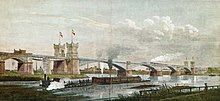Rheinhausen – Hochfeld route
The Rheinhausen-Hochfeld trajectory was built by the Rheinische Eisenbahn-Gesellschaft and was put into operation as a railway ferry on August 23, 1866 .
history
After the development of the left bank of the Rhine with railway lines from Kleve via Cologne and Aachen to Bingerbrück , the Rheinische Eisenbahn-Gesellschaft was looking for a rail connection to the Ruhr coal mine in the Ruhr area under its president, the Secret Commerce Councilor Mevissen . The very lucrative coal traffic there has so far only been carried out by the Cologne-Minden Railway Company and the Bergisch-Märkische Railway Company .
Construction of the train station
The planning begun around 1860 envisaged a new railway line from Osterath on the Cologne – Krefeld line over the Rhine to Essen and later on to Dortmund . Since at that time the Prussian military still refused to have permanent bridges on the Rhine outside the fortified cities, the only option was to build a trajectory between Rheinhausen on the left bank of the Rhine and the Duisburg district of Hochfeld . The Prussian concessions were granted for the railroad on March 9, 1863 and for the trajectory on July 16, 1863. While the construction of the railway line started immediately, the Rheinische Eisenbahn was waiting for the completion of its Spyck – Welle trajectory in order to be able to take over the technology that was still being tested there.
The Rheinische Eisenbahn-Gesellschaft anticipated a high volume of traffic and planned five train routes. In the final stage, five ferry pontoons with passenger and freight cars were to cross the Rhine independently of one another between two wire ropes. However, only four trajectory roads actually went into operation. The track ramps led down from the marshalling yards on both banks to the water with an incline of 1:48. Larger harbor basins were dredged on the banks to keep the moorings free from the current. The cultural port of Duisburg still exists today on the right bank of the Rhine .
Five ferry pontoons were ordered from the Cologne machine shop in Cologne-Bayenthal to transport the wagons. The 47 meter long pontoons “Ruhr”, “Lahn” and “Mosel” could each carry eight freight cars or five passenger cars. The fourth Ponte, the 63 meter long “Rhine”, carried ten freight cars or seven passenger cars. The fifth Ponte, called "Eisponte", held five freight cars. A steam engine with 30 HP power was installed next to the track on each ponte, which pulled the ponte over the Rhine on the pulling rope via a gearbox and a 2.5 meter pulley. The wagons were pushed onto the Ponte over a mobile landing bridge with light intermediate wagons or pulled off on the other bank.
The pontoons were led across the river on a 65 millimeter thick wire rope. A second wire rope served as a pulling rope, it was moved by the steam engine set up on the Ponte using two pulleys.
The Rheinische Eisenbahn-Gesellschaft was able to open the trajectory with two ferry routes for goods traffic on August 23, 1866 and for passenger traffic on September 1, 1866. The third and fourth ferry routes were not completed until the following year. Due to storms, floods and ice, the ferry traffic was paralyzed for about four weeks each year. Nevertheless, the capacity of the trajectory increased from 104,000 cars and 51 locomotives in 1867 to almost 350,000 cars and 286 locomotives in the last year of operation in 1873. More than 8 million hundredweight of coal were transported across the Rhine in 1867 and over 28 million hundredweight in 1873.
Problems were caused by the excessive wear on the ropes, which meant that they had to be replaced frequently. The landing sites also silted up quite easily and had to be dredged regularly.
End of trajectory operation
The constant efforts of the railway company to get approval for the construction of a bridge over the Rhine were ultimately successful.
The construction of the Duisburg-Hochfelder railway bridge was approved on July 29, 1871 and construction began immediately.
Freight train traffic began on December 24, 1873, and passenger cars were still hauled until January 14, 1874.
literature
- Emil Hartwich: Extension of the Rhenish Railway. 2. Department: Ferry companies for rail traffic. With 7 panels. 2nd Edition. Ernst & Korn, Berlin 1870 (reprint, edited by Ernst Werner. Braun, Duisburg 1979, ISBN 3-87096-156-2 ).
- Friedrich Albert Meyer: Rheinhausen am Niederrhein in the historical process. A house and handbook for the Rheinhauser area. Source history, geological novel of the Rheinhauser area, the name Rheinhausen, the settlement, the river and the human being, outline of a history of the traffic in and around the Rheinhauser area. City administration Rheinhausen, Rheinhausen 1956 ( publication series of the city Rheinhausen 1, ZDB -ID 638297-6 ).
- Rheinische Eisenbahn-Gesellschaft: Report on the results of the administration, construction and operation of the Rheinische Eisenbahn. 1862-1874, ZDB ID 611463-5 .
- Rheinische Eisenbahn-Gesellschaft: Business reports. 1875-1882, ZDB -ID 611464-7 and ZDB -ID 611465-9 .
- C. Switching brand : Trajectanstalten. In: Journal of the Association of German Engineers. With panel paintings. 14, 1870, ISSN 0341-7255 , col. 13-24, 565-574, 629-636, 695-706.
- Hans Schlieper: Railway trajectories across the Rhine and Lake Constance. Alba Verlag, Düsseldorf, 2009, ISBN 978-3-87094-369-1 .


